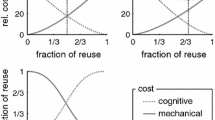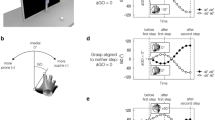Abstract
Manual asymmetries in the control of movements have been investigated in a variety of experimental paradigms. Initial studies demonstrated that the dominant right hand has advantages over the non-dominant left hand in many aspects of motor control. However, more recent studies have shown that the presence and extent of these asymmetries depends on the task context and accuracy demands. Typically, manual asymmetries on a motor planning and motor execution level are examined separately. However, given that recent research has demonstrated that specific task constraints do not influence both levels equally, the purpose of the present experiment was to investigate manual asymmetries in motor planning and execution. To this end, initial grasp behavior (motor planning) and kinematics (motor execution) were examined in thirteen right-handed participants during a unimanual grasping and placing task. We specifically manipulated grasping hand, target location, object end orientation, and object grasp time at the start location. There were three main findings. First, motor planning or movement execution was similar regardless of grasping hand. Second, prospectively planned actions were influenced by target location and the required end orientation of the object. Third, the amount of time spent in an initial posture did not influence initial grasp postures. However, it did alter the movement kinematics during the grasping (approach phase) and placing (transport phase) portion of the task. We posit that grasping and placing movements are comprised of an initial grasp and a transport component, which are differentially influenced by task constraints.


Similar content being viewed by others
Notes
A Likert-type scale is commonly used to measure attitude, providing a given range of responses to a given statement. The response categories in Likert scales have a rank order, but the intervals between values cannot be presumed equal (Blaikie 2003).
In order to control for perceptual effects associated with object perception, half of the subjects performed the task when the object was placed red end down at the start of the trial and the other half performed the task when the object was placed grey end down at the start of the trial.
For all participants, this was the marker located on the styloid process of radius.
The Woltring filter is commonly in the analysis of motion capture data and is equivalent to a double Butterworth filter. The benefit to the Woltring filter is that higher-order derivatives can be calculated from the analytic derivative of the polynomial spline.
We are aware that the differences in kinematics between the rotation and no rotation trials are in part due to the initial grasp posture (thumb up versus thumb down). We would have examined differences in kinematics based on the initial grasp posture; however, a number (n = 6) of the participants used the same initial grasp posture in 100% of the trials for each condition (no rotation versus rotation). Thus, when pooling the data across initial grasp posture, we encountered an empty cell problem. We do not use partial deletion techniques (listwise or pairwise) to treat the data because such techniques would have reduced the dataset to seven participants, (and thus decreased statistical power).
We thank an anonymous reviewer for pointing this out.
References
Annett J, Annett M, Hudson PT, Turner A (1979) The control of movement in the preferred and non-preferred hands. Q J Exp Psychol 31:641–652
Blaikie N (2003) Analysing quantitative data. Sage Publications, London
Boulinguez P, Velay JL, Nougier V (2001) Manual asymmetries in reaching movement control. II: study of left-handers. Cortex 37:123–138
Brinkman J, Kuypers HG (1972) Splitbrain monkeys: cerebral control of ipsilateral and contralateral arm, hand, and finger movements. Science 176:536–539
Bryden PJ (2000) Lateral preferences, skilled behavior and task complexity: hand and foot. In: Mandal MK, Bulman-Fleming MB, Tiwari G (eds) Side bias: a neuropsychological perspective. Kluwer, Dordrecht, pp 225–248
Bryden PJ, Roy EA (1999) Spatial task demands affect the extent of manual asymmetries. Laterality 4:27–37
Carey DP, Otto-de Haart EG (2001) Hemispatial differences in visually guided aiming are neither hemispatial nor visual. Neuropsychologia 39:885–894
Carey DP, Hargreaves EL, Goodale MA (1996) Reaching to ipsilateral or contralateral targets: within-hemisphere visuomotor processing cannot explain hemispatial differences in motor control. Exp Brain Res 112:496–504
Carson RG, Elliott D, Goodman D, Thyer L, Chua R, Roy EA (1993) The role of impulse variability in manual-aiming asymmetries. Psychol Res 55:291–298
Cohen R, Rosenbaum D (2004) Where grasps are made reveals how grasps are planned: generation and recall of motor plans. Exp Brain Res 157:486–495
Cohen RG, Rosenbaum DA (2011) Prospective and retrospective effects in human motor control: planning grasps for object rotation and translation. Psychol Res 75:341–349
Colebatch JG, Deiber MP, Passingham RE, Friston KJ, Frackowiak RS (1991) Regional cerebral blood flow during voluntary arm and hand movements in human subjects. J Neurophysiol 65:1392–1401
Cooperau LA, Shepard RN (1973) The time required to prepare for a rotated stimulus. Mem Cogn 1:246–250
Coren S, Porac C (1977) Fifty centuries of right-handedness: the historical record. Science 198:631–632
Crajé C, van der Kamp J, Steenbergen B (2009) Visual information for action planning in left and right congenital hemiparesis. Brain Res 1261:54–64
Dragovic M (2004) Categorization and validation of handedness using latent class analysis. Acta Neuropsychiatrica 16:212–218
Elliott D, Chua R (1996) Manual asymmetries in goal-directed movements. In: Elliott D, Roy EA (eds) Manual asymmetries in motor performance. CRC, Boca Raton, pp 143–158
Elliott D, Lyons J, Chua R, Goodman D, Carson RG (1995) The influence of target perturbation on manual aiming asymmetries in right-handers. Cortex 31:685–697
Evarts EV (1966) Pyramidal tract activity associated with a conditioned hand movement in the monkey. J Neurophysiol 29:1011–1027
Fischer SC, Pellegrino JW (1988) Hemisphere differences for components of mental rotation. Brain Cogn 7:1–15
Fisk JD, Goodale MA (1985) The organization of eye and limb movements during unrestricted reaching to targets in contralateral and ipsilateral visual space. Exp Brain Res 60:159–178
Flowers K (1975) Handedness and controlled movement. Br J Psychol 66:39–52
Gazzaniga MS, Bogen JE, Sperry RW (1967) Dyspraxia following division of the cerebral commissures. Arch Neurol 16:606–612
Goble DJ, Brown SH (2008) The biological and behavioral basis of upper limb asymmetries in sensorimotor performance. Neurosci Biobehav Rev 32:598–610
Grafton ST, Woods RP, Mazziotta JC (1993) Within-arm somatotopy in human motor areas determined by positron emission tomography imaging of cerebral blood flow. Exp Brain Res 95:172–176
Haaland KY, Harrington DL (1996) Hemispheric asymmetry of movement. Curr Opin Neurobiol 6:796–800
Haaxma R, Kuypers HG (1975) Intrahemispheric cortical connexions and visual guidance of hand and finger movements in the rhesus monkey. Brain 98:239–260
Hausmann M, Kirk IJ, Corballis MC (2004) Influence of task complexity on manual asymmetries. Cortex 40:103–110
Herbort O, Butz MV (2010) Planning and control of hand orientation in grasping movements. Exp Brain Res 202:867–878
Hermsdorfer J, Laimgruber K, Kerkhoff G, Mai N, Goldenberg G (1999) Effects of unilateral brain damage on grip selection, coordination, and kinematics of ipsilesional prehension. Exp Brain Res 128:41–51
Hughes CML, Franz EA (2008) Goal-related planning constraints in bimanual grasping and placing of objects. Exp Brain Res 188:541–550
Hughes CML, Haddad JM, Franz EA, Zelaznik HN, Ryu JH (2011a) Physically coupling two objects in a bimanual task alters kinematics but not end-state comfort. Exp Brain Res 211:219–229
Hughes CML, Reißig P, Seegelke C (2011b) Motor planning and execution in left- and right-handed individuals during a bimanual grasping and placing task. Acta Psychol. doi:10.1016/j.actpsy.2011.05.013
Janssen L, Beuting M, Meulenbroek R, Steenbergen B (2009) Combined effects of planning and execution constraints on bimanual task performance. Exp Brain Res 192:61–73
Janssen L, Meulenbroek RGJ, Steenbergen B (2011) Behavioral evidence for left-hemisphere specialization of motor planning. Exp Brain Res 209:65–72
Johnson-Frey S, McCarty M, Keen R (2004) Reaching beyond spatial perception: effects of intended future actions on visually guided prehension. Vis Cogn 11:371–399
Kim SG, Ashe J, Hendrich K, Ellermann JM, Merkle H, Uğurbil K, Georgopoulos AP (1993) Functional magnetic resonance imaging of motor cortex: hemispheric asymmetry and handedness. Science 261:615–617
Lawrence DG, Kuypers HG (1968a) The functional organization of the motor system in the monkey. I. The effects of bilateral pyramidal lesions. Brain 91:1–14
Lawrence DG, Kuypers HG (1968b) The functional organization of the motor system in the monkey. II. The effects of lesions of the descending brain-stem pathways. Brain 91:15–36
Mason AH, Bryden PJ (2007) Coordination and concurrency in bimanual rotation tasks when moving away from and toward the body. Exp Brain Res 183:541–556
Mieschke PE, Elliott D, Helsen WF, Carson RG, Coull JA (2001) Manual asymmetries in the preparation and control of goal-directed movements. Brain Cogn 45:129–140
Mutsaarts M, Steenbergen B, Bekkering H (2005) Anticipatory planning of movement sequences in hemiparetic cerebral palsy. Mot Control 9:439–458
Mutsaarts M, Steenbergen B, Bekkering H (2007) Impaired motor imagery in right hemiparetic cerebral palsy. Neuropsychologia 45:853–859
Nirkko AC, Ozdoba C, Redmond SM, Bürki M, Schroth G, Hess CW, Wiesendanger M (2001) Different ipsilateral representations for distal and proximal movements in the sensorimotor cortex: activation and deactivation patterns. NeuroImage 13:825–835
Peters M (1976) Prolonged practice of a simple motor task by preferred and nonpreffered hands. Percept Mot Skills 42:447–450
Peters M, Durding B (1979) Left-handers and right-handers compared on a motor task. J Mot Behav 11:103–111
Rosenbaum DA, Jorgensen MJ (1992) Planning macroscopic aspects of manual control. Hum Mov Sci 11:61–69
Rosenbaum DA, Marchack F, Barnes HJ, Vaughan J, Slotta JD, Jorgensen MJ (1990) Constraints for action selection: overhand versus underhand grips. In: Jeannerod M (ed) Attention and performance XIII. Erlbaum, Hillsdale, pp 321–342
Rosenbaum DA, Vaughan J, Jorgensen MJ, Barnes HJ, Stewart E (1993) Plans for object manipulation. In: Meyer DE, Kornblum S (eds) Attention and performance XIV (silver jubilee volume): synergies in experimental psychology artificial intelligence and cognitive neuroscience. MIT Press, Cambridge, pp 803–820
Roy EA, Elliott D (1989) Manual asymmetries in aimed movements. Quart J Exp Psychol Sect A Hum Exp Psychol 41:501–516
Roy EA, Kalbfleisch L, Elliott D (1994) Kinematic analyses of manual asymmetries in visual aiming movements. Brain Cogn 24:289–295
Roy EA, Winchester T, Elliott D, Canahan H (1995) Manual asymmetries in visual aiming movements: the effect of spatial variability. J Inter Neuropsychol Soc 1:133
Shepard RN, Cooper LA (1982) Mental images and their transformations. MIT Press, Cambridge
Shepard RN, Metzler J (1971) Mental rotation of three-dimensional objects. Science 171:701–703
Steenbergen B, Meulenbroek RGJ, Rosenbaum DA (2004) Constraints on grip selection in hemiparetic cerebral palsy: effects of lesional side, end-point accuracy, and context. Cogn Brain Res 19:145–159
Todor JI, Cisneros J (1985) Accommodation to increased accuracy demands by the right and left hands. J Mot Behav 17:355–372
Todor JI, Kyprie PM (1980) Hand differences in the rate and variability of rapid tapping. J Mot Behav 12:57–62
Todor JI, Kyprie PM, Price HL (1982) Lateral asymmetries in arm, wrist and finger movements. Cortex 18:515–523
Weigelt M, Kunde W, Prinz W (2006) End-state comfort in bimanual object manipulation. Exp Psychol 53:143–148
Woltring HJ (1986) A Fortran package for generalized, cross-validatory spline smoothing and differentiation. Adv Eng Softw Workst 8:104–113
Woodworth RS (1899) The accuracy of voluntary movement. Psychol Rev 3:1–119
Acknowledgments
This research was funded by the German Research Foundation (DFG; EC 277). Christian Seegelke gratefully acknowledges the financial support from Honda Research Institute Europe.
Author information
Authors and Affiliations
Corresponding author
Rights and permissions
About this article
Cite this article
Seegelke, C., Hughes, C.M.L. & Schack, T. An investigation into manual asymmetries in grasp behavior and kinematics during an object manipulation task. Exp Brain Res 215, 65–75 (2011). https://doi.org/10.1007/s00221-011-2872-z
Received:
Accepted:
Published:
Issue Date:
DOI: https://doi.org/10.1007/s00221-011-2872-z




